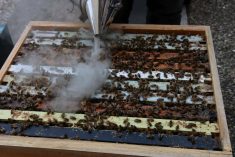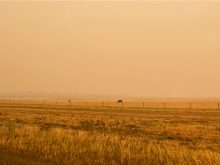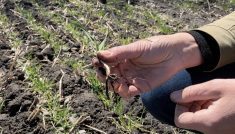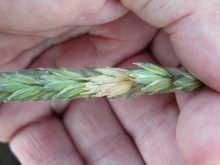CNS Canada — Despite the dry conditions gripping much of southern Saskatchewan, farmers in most of the province have something to cheer about, at least in terms of crop development.
Saskatchewan Agriculture says in its weekly crop report released that most crops are developing normally.
The report, covering the July 4-10 period, stated 84 per cent of fall cereals, 69 per cent of spring cereals, 67 per cent of oilseeds and 80 per cent of pulses are at normal or ahead of normal development for this time of year. However, lack of rain and heat during the last two weeks have deteriorated crops.
Read Also

Lightning gives and takes in Prairie fields
Lightning in fields can be a source of nitrogen but at times can result in crop damage which, at a glance, resembles a very localized disease outbreak, plant pathologist Ieuan Evans writes.
Some areas received rain during the week, but many crops still need significant rain to develop, the crop report said.
Rain ranged from trace amounts to 80 mm around Kelvington.
Provincewide, topsoil moisture on cropland is rated two per cent surplus, 41 per cent adequate, 46 per cent short, and 11 per cent very short. Hay land and pasture topsoil is rated as three per cent surplus, 32 per cent adequate, 49 per cent short and 16 per cent very short.
Heat and rain shortages are damaging crops, especially in the southern part of the south region, but also stretching into some central areas of the grain belt.
Many areas in the south and central regions have received less than 100 mm of moisture since April 1. In the southwest, topsoil moisture on cropland is rated 21 per cent adequate, 55 per cent short and 24 per cent very short. In the southeast, topsoil moisture on cropland is rated one per cent surplus, 38 per cent adequate, 54 per cent short and seven per cent very short.
Some crops in the driest areas are short, thin and heading out or flowering earlier than normal because of heat stress. Field are variable, depending on which were lucky enough to receive rain.
Precipitation during the next two weeks could still help with pod fill and head fill, although some yield loss is inevitable in the driest areas.
Producers also reported crop damage from hail, localized flooding, wind and insects. Alfalfa weevils, painted lady caterpillars and wheat midge have been sighted. Leaf spot and root rot are also causing damage.
Producers in the province have cut about 25 per cent of the hay crop and baled or put into silage about 40 per cent. Quality is rated as 17 per cent excellent, 59 per cent good, 22 per cent fair and two per cent poor.














